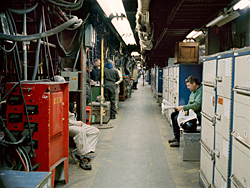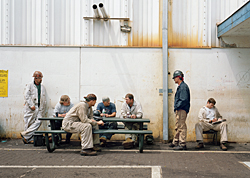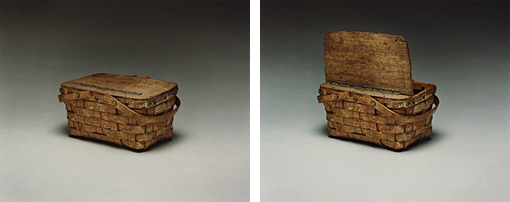Los Angeles-based conceptual artist Sharon Lockhart creates films and photographs that are at once rigorously formal and deeply humanistic, meticulously observing the details of everyday life while also probing the limits and intersections between the two mediums.
As much as Lockhart’s photographs reveal cinematic qualities of staging and casting, so, too, do her films frequently engage a static camera and angles that recall photographic practices.

Beginning Friday, Feb. 5, the Mildred Lane Kemper Art Museum will present “Sharon Lockhart: Lunch Break,” a one-person exhibition showcasing the artist’s most recent series.
Inspired by the shifting world economy and its effect on American labor, Lockhart spent a year observing and engaging workers at the Bath Iron Works, a major shipyard and U.S. Navy supplier located in Bath, Maine.
The resulting works, collectively titled “Lunch Break,” include two large-scale film installations and three distinct sets of photographs that together explore the daily routines and social activities of workers during their time away from production.
The centerpiece of the exhibition is the titular film “Lunch Break,” which consists of a single, slow-moving tracking shot down a long and seemingly endless interior corridor. To create the piece, Lockhart recorded a 10-minute walk-through — her first use of a mobile camera — and then employed digital technology to stretch the length to 80 minutes. This extreme slow motion imbues ordinary lunchtime activities — eating, reading, talking and sleeping — with an almost baroque sense of anticipation, yet the film ultimately refuses cathartic narrative closure. The result is a meditative reflection, devoid of sentiment, on aspects of factory life that typically remain hidden from outside view.
By contrast, the second film, “Exit,” is divided into five sections — one for each day of the work week — and depicts workers as they depart the complex at the end of their shifts. Employing a static camera, the film recalls Louis Lumiere’s historic “Leaving the Lumiere Factory” (1895), a 46-second black-and-white short that is widely considered to be the first true motion picture.
Yet, Lockhart subtly reverses Lumière’s viewpoint. Rather than observe workers as they stream toward an exterior camera, she films from within factory grounds, focusing on workers’ backs as they seemingly stage their own exits.

The first of the three series of photographs centers on workers’ lunch boxes, emphasizing the ways in which stickers, labels, contents and other minute details suggest the personalities of their owners.
A second series is devoted to the independent businesses that exist within the factory — makeshift booths where workers sell hot dogs, coffee and other items to their colleagues. The third series consists of carefully composed images of workers lingering around lunch tables, at once recalling and revising historical traditions of group portraiture.
“Sharon Lockhart: Lunch Break” is organized by Sabine Eckmann, Ph.D., director and chief curator of the Kemper Art Museum. The exhibition will be on view at the Kemper through April 19, then will travel to the Colby College Museum of Art in Maine, where it will be on view July 10-Oct. 17, 2010; and to the San Francisco Museum of Modern Art, where it will be on view May 21-Sept. 6, 2011.
Support for “Sharon Lockhart: Lunch Break” is provided by the Andy Warhol Foundation for the Visual Arts; James M. Kemper Jr.; the David Woods Kemper Memorial Foundation; the Missouri Arts Council, a state agency; Helen Kornblum; and members of the Mildred Lane Kemper Art Museum.
CATALOG
A fully illustrated color catalog will accompany the exhibition and will be distributed by the University of Chicago Press. The catalog will include essays by Eckmann, Mark Godfrey and Matthias Michalka, as well as an interview by filmmaker James Benning, in which Sharon Lockhart discusses her creative process, and an interview with architects Frank Escher and Ravi GuneWardena, conducted by Andras Palffy.

SHARON LOCKHART
Born in Norwood, Mass., in 1964, Lockhart earned a bachelor of fine arts degree from the San Francisco Art Institute in 1991 and a master’s of fine arts from the Art Center College of Design in Pasadena in 1993. Her early work took frequent inspiration from 1970s art cinema.
For the photo series “Auditions” (1994), Lockhart enlisted Los Angeles schoolchildren to restage the first-kiss scene from Francois Truffaut’s “Small Change” (1976). Her debut film, the short “Khalil, Shaun, A Woman Under the Influence” (1994), re-enacted moments from John Cassavetes’ “A Woman Under the Influence” (1974).
Subsequent projects have revealed an almost ethnographic interest in “foreign” cultures, often blurring distinctions between documentary and intervention. “Goshogoaka” (1997) depicts a girls’ basketball team in rural Japan executing a series of highly choreographed drills. “Teatro Amazonas” (1999) focuses on an opera house audience in Manaus, Brazil, while an off-camera choir sings minimalist compositions.
“NO” (2003) records the meticulous workday of Japanese farmers Yoko and Masa Ito. For “Pine Flat” (2006), Lockhart established a portrait studio amidst the Sierra Nevada Mountains and spent three years capturing images of local children as they play, rest, read and hang out.
Lockhart’s films and photographs have been featured in major exhibitions and international film festivals, including the Whitney Biennial (2000 and ’04), the Carnegie International (2008) and the Sundance Film Festival (2006 and ’09).
Her work is included in the permanent collections of The Art Institute of Chicago, the Los Angeles County Museum of Art, the Tate Modern in London, the Israel Museum in Jerusalem, the Yokohama Museum of Art in Japan, and the Solomon R. Guggenheim Museum and Metropolitan Museum of Art in New York, among many others.
Additional honors include grants and fellowships from the Rockefeller Foundation, the Japan Foundation, the John Simon Guggenheim Memorial Foundation, the California Community Foundation and the LEF Foundation.
Lockhart is currently an associate professor of photography at the University of Southern California’s Roski School of Fine Arts.

MILDRED LANE KEMPER ART MUSEUM
The Mildred Lane Kemper Art Museum, part of Washington University’s Sam Fox School of Design & Visual Arts, is committed to furthering critical thinking and visual literacy through a vital program of exhibitions, publications and accompanying events. The museum dates back to 1881, making it the oldest art museum west of the Mississippi River. Today, it boasts one of the finest university collections in the United States.
“Sharon Lockhart: Lunch Break” will open with a reception at 7 p.m. Friday, Feb. 5, and remain on view through April 19. In addition, Lockhart will host an exhibition walk-through at 2 p.m. Saturday, Feb. 6.
Both the reception and the walk-through are free and open to the public. The Kemper Art Museum is located on Washington University’s Danforth Campus, near the intersection of Skinker and Forsyth boulevards. Regular hours are 11 a.m.-6 p.m. Mondays, Wednesdays and Thursdays; 11 a.m.-8 p.m. Fridays; and 11 a.m. to 6 p.m. Saturdays and Sundays. The museum is closed Tuesdays.
For more information, call (314) 935-4523 or visit kemperartmuseum.wustl.edu.
|
WHO: Mildred Lane Kemper Art Museum WHAT: Exhibition, “Sharon Lockhart: Lunch Break” WHEN: Feb. 5-April 19. Opening reception 7-9 p.m. Friday, Feb. 5. Walk-through with the artist 2 p.m. Saturday, Feb. 6. WHERE: Mildred Lane Kemper Art Museum, Washington University in St. Louis, near the intersection of Forsyth and Skinker boulevards. HOURS: 11 a.m.-6 p.m. Monday, Wednesday and Thursdays; 11 a.m.-8 p.m. Fridays; 11 a.m.-6 p.m. Saturdays and Sundays. Closed Tuesdays. COST: Free and open to the public. INFORMATION: (314) 935-4523 or www.kemperartmuseum.wustl.edu
|
Editor’s Note: High-resolution images are available upon request.